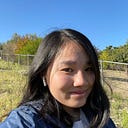CS476A HW #1
Reading Response #1
to Artful Design • Chapter 1: “Design Is ______”
Amy Lo – 10/4/2023
Music 256A / CS476a, Stanford University
Reading Response: Ends in Themselves
From this week’s reading, I’d like to respond to Artful Design Principle 1.5, which states:
— where means are “means to ends” (something that serves another purpose) and ends are “ends in themselves” (something worthwhile in itself).
I encountered this principle over the weekend when I folded dumplings. To design a dumpling is an artful labor of love. A dumpling without a defined form would be nothing more than boiled dough and meat. Each time I make a dumpling, I meticulously create small crimps in the handmade dough using my grandmother’s special recipe for the filling. This process connects me to my past, reminding me of how I felt as a child when I first learned to handle the squishy, pliable dough. Now, my ease at folding dumplings reflects not only my age and experience but also the depth of my family’s love. Even the repetitive process of folding a dumpling is like a meditative session that invokes nostalgia and goodwill.
A dumpling, gentle, small, and delicate, is a food meant to be shared, eaten, and made in bulk. It is a means-to-an-end, structurally designed to encase delicious pork and cabbage filling through its folds. However, it inspires ends-in-itself — the family I bonded with, the experience of making dumplings, and the artful expression of love experienced through constant reflexive recall.
In addition, I’d like to make a connection between this and Principle 1.9: Design is Addition. Over the summer, I hosted a painting night, where my friends and I crowded around my tiny dining room table. We all started paintings, with the twist: every 5 minutes, we would have to switch. While adding to each others’ paintings made the process more complex, the paintings themselves became something that would not exist in the world from my ideation alone.
My friends’ acts of instantiation — adding a cat into the scene, painting the starry background, adding an extra booger to the wizard — are intentionally done with both the aesthetic purpose of imbuing the painting with personality, and the pragmatic purpose of filling up the page and interacting with the tactile experience of painting. The constraints themselves gave rise to interactions between artists that led to the final whimsical aesthetic. When I decided to frame this painting and make it a dominant piece on my wall, I substantiated the painting as an artful design. There is something beautiful about the way that the painting looks and the way it was made — through the collaboration of friends.
Last but not least, the humble balloon dog connects to our class discussion about the political nature of artful design. The form of the ballon dog is its purple, bulbous shape and rotund features. However, its function as a balloon is to hold air. When shaped, the function of the balloon also becomes the form. Through my careful twisting of the balloon, it is anthropomorphized to look like a dog with two ears, four legs, a nose, and a tail.
The rubber balloon is responsive. But too much air or pressure, it’ll pop from operator error. In a sense, the balloon dog articulates the choices of its maker to specify the specific features of a dog it deems most necessary, reinforced by the imminent danger of the balloon about to pop. This risk symbolizes the challenges and uncertainties that artists face when expressing their ideas, reinforcing the idea that balloon art involves choices with consequences.
Using the artful design lens, my dumplings, wizard painting, and balloon dog show that choice is an important factor in the interplay of form vs. function.
Programming
Link to Chuck file: https://drive.google.com/file/d/1T_AMyXMIoM4_lhfy20XXLAD8KwxmKvOM/view?usp=sharing
